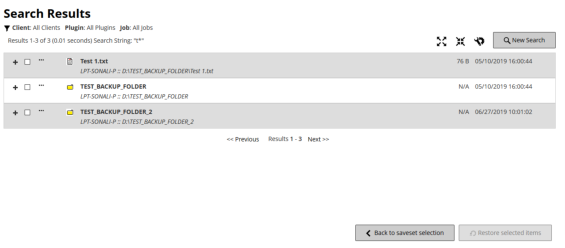Restoring data using an existing Restore Selection Set
|
1 |
In the Navigation pane, click Manage Sets. |
|
2 |
|
4 |
|
NOTE: To preview the selection set summary and plug-in options set summary, move the pointer over the information icons on Edit Selection Set page. |
|
5 |
Searching for files in savesets
The Search All / Search Selected Saveset(s) option on the Create Restore Job — Choose Saveset page allows you to find specific files or data items without opening any savesets or browsing through their contents. You can use filenames or regular expressions to find the data items that you want to restore.
To conduct a catalog search within a saveset, click the bulb icon shown near Search All or Search Selected Saveset(s) button on the Create Restore Job — Choose Saveset page.
|
1 |
On the Create Restore Job — Choose Saveset page, select a saveset and then click Search Selected Saveset(s). |
|
2 |
In the Search for files in savesets details drawer, enter the following criteria. |
|
NOTE: By default, the simple search uses the wildcards “*” meaning “match anything” and “?” meaning “match one character.” To use a full-featured Portable Operating System Interface for Unix (POSIX) regular expression, select Regular expression search next to each applicable option. |
|
In the text box, enter a string of words that are associated with the selected criteria. | |
|
Enter the job name that applies to the file that you want to find. | |
|
Enter the name of the backup selection set that contains the file that you want to find. | |
|
Under From, enter the earliest time and date of your search range in the respective text boxes. Under To, enter the latest time and date of your search range in the respective text boxes. | |
|
Under From, enter the earliest time and date of your search range in the respective text boxes. Under To, enter the latest time and date of your search range in the respective text boxes. | |
|
Enter the Min (minimum) and Max (maximum) size, in bytes, for the search range. | |
|
Expand to reveal the available options, and then select the job or jobs that relate to your search. | |
|
3 |
Click Search. |
|
• |
|
• |
|
• |
Expand icon: To expand all result items, click the expand icon shown on top of the results table. |
|
• |
Collapse icon: To collapse all result items, click the collapse icon shown on top of the results table. |
|
• |
Settings icon: To set the number of search results per page, click the settings icon. ‘Settings’ drawer is displayed on the right- side of the page. Type or select the value and click OK. By default, the page displays 25 records. You can view a minimum 10 and maximum 100 records on the Search Results page. |
|
• |
New Search button: To search the data items in the selected saveset, click New Search. |
|
• |
The Search for Files in Savesets details drawer opens. Repeat steps 1-3.To expand an item and view the file metadata, such as plug-in, job name, job ID, saveset ID, and backup date and time, click the corresponding plus icon. |
|
• |
|
• |
The Filepath link appears below the filename. To search within this location, click the link. The Search for Files in Savesets drawer opens with the Path automatically populated. |
|
• |
|
4 |
Select the items you want to restore. You can only restore items from one saveset. Click Restore selected items. |
|
5 |
Viewing media list
The Media List option on the Create Restore Job — Choose Saveset page lets you view information about the media items used to store a backup. Only MSP administrator can view details about the data segments and index segments for a backup. Tenant administrator and Tenant user do not have permissions to view the details.
|
1 |
On the Create Restore Job — Choose Saveset page, select the applicable saveset. |
|
2 |
|
• |
Backup size: This area shows the total size of the saveset in number of bytes |
|
• |
Data segment table: This table shows information about the media items that contain the data segments. You can view the following details: media label, media group label, stream ID, starting byte number, ending byte number, and media location |
|
• |
Index segment table: This table shows information about the media items that contain the index segments. You can view the media label and media location. |
|
4 |
Click Close to close the dialog box. |
Creating Source Sets for restore jobs
A Source Set is used to specify source device options. You can create Source Sets for restore jobs from the Create Restore Job page.
|
1 |
|
2 |
On the Create Restore Source Set page, click Device Selection, and configure the following settings. |
|
To use only devices that are locally attached to the target client, select this check box. |
|
3 |

